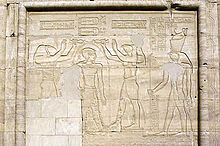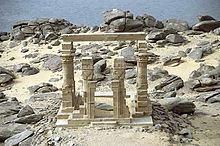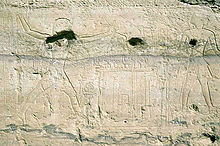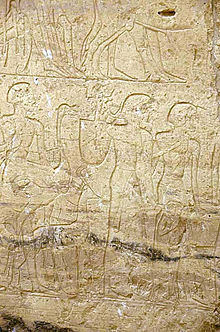 Kalabsha Temple as seen from the Aswan High Dam | ||
| New Kalabsha · كلابشة الجديدة | ||
| Governorate | Aswan | |
|---|---|---|
| height | 191 m | |
| no tourist info on Wikidata: | ||
| location | ||
| ||
New Calabash or Kalabsha el-Gadida (also Kalabsha (h), Calabshe (h), Kalabchah, Arabic:كلابشة الجديدة, Kalabsha al-Hadida) or. New Aswan or Aswan el-Gadida (Arabic:اسوان الجديدة, Aswān al-Hadīda) is island with an archaeological site near the west bank of the Lake Nasser in Egypt, about 9 kilometers south of the Aswan High Dam. Here the temples of Kalābscha and Beit el-Wālī, the kiosk of Qirtāsī and the chapel of Dedun were rebuilt because they were in their original locations by the water masses of the Lake Nasser would have been flooded. The pharaonic monuments on Lake Nasser belong to the Unesco world heritage site.
background
getting there

By car and boat
New Kalabsha has no road access.
The visit to New Kalabsha / New Aswan can be combined with that of the Aswan High Dam, from which the Mandulis Temple is already visible. With a taxi you drive along the airport road over the high dam, past the 1 High Dam Monument and at one 1 Canned Fish Factoryuntil 2 Boat dock to New Kalabsha / New Aswan. The island of New Kalabsha can be reached via the 3 Landing stage and another one to the south 4 Landing stage on the east side of the island.
The taxi ride costs around LE 50. One 5 parking spot is located north of the Hochdamm Monument. Motor boats can be used to reach the archaeological site. Dealing with the skippers is difficult, LE 30s are certainly sufficient for the crossing and a one-hour stay. However, the boat drivers often ask for LE 100. One hour is sufficient for an overview visit. If you want to visit more, you should expect two to three hours.
By train
Third-class trains run from Aswan to Hochdamm every hour. The fare is approx. LE 1. The 6 last stop is southeast of the high dam near the ferry port after Wadi Halfa. From here you have to try to hitchhike to the boat dock, which shouldn't be easy.
cruise
Visiting New Kalabsha is also possible with a cruise on the Lake Nasser possible. This also makes it possible to visit all the monuments along Lake Nasser.
mobility
The area is manageable and all sites are within walking distance.
Tourist Attractions
Opening hours: 9 am–5pm. The admission price is LE 60 and LE 30 for students (as of 11/2019)
Mandulis Temple of Kalabsha






The 2 Temple of Kalabsha, معبد كلابشة, Maʿbad Kalābsha, is the sububian god of sun and fertility Mandulis (also Merul), the local god equated with the local Horus. The temple was originally located about 50 km south of Aswan on the west bank of the Nile in Kalābscha (Arabic:كلابشة, The ancient (Greek) Talmis (old-Äg. Termes). Today's temple is a new building from the time of the Roman emperor Augustus, who built his temple on the foundation walls of a temple to Ptolemy VII, who in turn built his temple on the site of a sanctuary from the 18th dynasty. The temple is one of the most beautiful and largest in Nubia, even if its decoration remained unfinished.
The 72 × 36 m Sandstone temple consists of an open courtyard, the temple vestibule and three consecutive sanctuary rooms. The temple, which is entered in the east via a 32 m long driveway, is surrounded by a stone wall. There is a nilometer in the southwest part of the gallery. To the northwest of the temple is a small chapel from the time of Ptolemy ’IX, which was dedicated to the triad of Elephanine, Khnum, Satis and Anukis.
When walking through the Pylons one recognizes on the right emperor Augustus before Horus. The 14 m high, hardly decorated pylon, which can be climbed via a staircase in its southern half, forms the eastern end of the forecourt with its colonnades with plant-capital columns originally on three sides. There are numerous undecorated rooms on the back of the colonnades.
The Temple front is formed by barrier walls with plant capital columns. On the left you can see Augustus being ritually cleansed by Thoth and Horus. On the opposite side you can see destroyed people in front of Mandulis and Isis. Several inscriptions adorn the right side, such as an inscription by the local strategist Aurelius Besarion, in which he urges the local swineherd to drive their cattle from the temple, two dedicatory inscriptions, a Meroitic inscription by the Blemmye king Kharamadeya and an inscription by the Christian king of Napata , Silko, who here praises his victory over the Blemmyes in Greek, which is in need of improvement. At the far right end you can see the graffiti of a Christian prince on horseback.
The one without a cover today Portico is only decorated on its back. Shown in three registers on the left, a Ptolemaic king makes sacrifices to various deities such as Horus of Edfu, Mandulis, Hathor, Harpocrates, Isis and Osiris; in the second register, the founder of the temple, Amenhotep II, sacrifices wine to Min-Re and Mandulis. The depiction of the 'Three Young Men in the Fiery Furnace' naturally comes from Christian times. Also on the right side you can see the king performing numerous sacrifices before numerous gods, here also before Amun, Thoth and Chons, in the top register you can see the king during the defeat of the enemy in front of Horus, Shu and Tefnut. On the lintel of the door you can see Emperor Trajan in a double scene, as he sacrifices to Mandulis, Osiris and Isis.
In the following two Lobbies and the Sanctuary one recognizes the king in numerous sacrifices before the local and other gods. In addition, in the first room you can see the representation of the gods on the lower wall areas. A staircase to the left in the first vestibule leads to the temple roof. In the rear sanctuary you can see on the back wall how the emperor sacrifices lotus flowers to Isis and Harpocrates or Mandulis and Buto (Wadjet). Further acts of sacrifice can be found on the remaining walls.
The Temple exterior are not decorated with the exception of the outer rear wall. In a double scene it shows the sacrificing king in front of Isis, Horus and Mandulis or in front of Osiris, Isis and Horus.
Some Christian representations testify to the use of the temple in Christian times.
With German help, the temple was relocated between 1961 and 1963 and was the first of the relocated monuments to be opened to the public in 1975. An earlier temple, found in its foundations when the Temple of Kalabsha was moved, was on the island Elephantine at Aswan rebuilt. The Ptolemaic gate of the temple was given to the Federal Republic of Germany as a gift. It's in today Donut Egyptian Museum on display.
Dedun rock chapel
To the southwest behind the temple complex you can still see the 3 Rock chapel of the Nubian god Dedun (Dedwen)[1], the donor of the incense. The Hemispeos consists of an 11.5 meter long open courtyard that was built in front of the rock and an adjoining rock chamber and was once located southwest outside the Mandulis Temple. The rock chamber itself had to be left behind. Only the lintel of the rock chamber was decorated. Immediately south of the rock chapel is the Amenemope stele, a rock stele that emerged from the southern mountain wall of the castle hill of Qaṣr Ibrīm was sawed. The founder Amenemope praises the victories of Seti I over the Nubians.
Qirṭāsī kiosk
The 4 Qirtāsī kiosk (also Qertassi and Kertassi,قرطاسي, Qirṭāsī, or Arabic:كيرتاسي, Kīrtāsī), the ancient Tzitzis or. Qirtās, is now located south of the Mandulis Temple. It originally stood between Dābōd (Debōd) and Tāffa (Tāfa) north of Kalābscha, about 40 km south of Aswan at the entrance to an ancient quarry. The kiosk is similar to the one in Philae Temple, it is about 8 × 10 m in size. Two Hathor and four plant composite columns are still part of the kiosk's decoration. Apart from several inscriptions on the pillars, one recognizes the pharaoh before Isis-Hathor and Harpocrates on the union symbol on the northwest pillar.
Temple of Ramses ’II of Beit el-Wālī




If you go north around the Mandulis Temple, you will reach it 5 Ramses ’II rock temple of Beit el-Wālī (بيت الوالي, Bait al-Wālī, „Governor's house“), Originally located between Qirtāsī and Kalābscha. The temple, which you enter in the east, is possibly dedicated to Amun-Re and consists of an elongated, 6 m wide and 12.5 m long vestibule, the lower part of which was carved out of the rock and closed with an adobe vault, the transverse pillared vestibule and the Sanctuary (Holy of Holies). The barrel vault, which is missing today, reveals the most historically valuable representations in the vestibule.
On the Post to the lobby Ramses II can be seen performing the cleaning ceremony, the reveals carry the Ramses ’II cartridges.
Ramses II left in the lobby depicting his campaigns against the Nubians (southern wall) and against the Syrians (northern wall). in the Fight against the Nubians one recognizes Ramses II with his two sons Amun-her-wenemef and Cha’emwaset in separate chariots as they drive over Nubians and drive Nubians in front of them. In front of the chariot you can see the Nubian village under palm trees with its inhabitants at work and the capture of Nubians. In another scene, Ramses II receives the tribute of the Nubians in a pavilion. Among them is a Nubian woman who carries her children in a basket.
In five scenes the Battle against the Syrians Shown on the north wall: In the presence of high officials, a prince Amun-her-wenemef brings prisoners in front of Ramses II in the pavilion, Ramses II knocks down a Syrian, Ramses II rolls over the Syrians with his chariot and drives others in front of him , Ramses II conquers a Syrian fortress and knocks down the Syrians.
The ones in the west adjoining transverse hall shows Ramses II in front of numerous sacrifices, suppression and ritual acts in front of Horus, Atum, Amun-Re, Hathor, Isis, Khnum, Anukis and Satis. In many cases, the representations still have their original paintwork. In the outer rear corners you can see a group of statues: on the left side Ramses II. Sits between Horus and Isis, on the right side between Khnum and Anukis. The columns and architraves bear inscriptions with the royal names and associated epithets.
Also in Sanctuary one finds Ramses II performing sacrificial and ritual acts, including how the young Ramses II is suckled by Anukis or Isis. The statue niche on the back wall has been destroyed: surely we would have a group comparable to that in the Great Temple of Abu Simbel found.
Temple of Garf Ḥusein
The temple of 6 Cooking up (also Gerf Hussein / Husein, جرف حسين, Ǧarf Ḥusain), was rebuilt west of the Qirṭāsī kiosk.
Steles
North of the temple house of the Mandulis Temple was the 7 Schellal stele with an inscription of Psammetich II. The stele, made of rose granite, comes from a quarry area south of Aswan.
To the south of the temple of Kalābscha several steles and rock remains with prehistoric rock carvings, so-called petroglyphs, were set up. Below is one 8 Stele Sethos ’I.
accommodation
Accommodation can be found in the nearby Aswan or on his cruise ship.
trips
- The visit to New Kalabsha can be compared to that of Aswan, the high dam of Aswan or other monuments on Lake Nasser connect.
literature
- Kalabsha Temple
- : Le temple de Kalabchah. Le Caire: Impr. De l’Inst. Français d. Archeology Orientale, 1911, Les Temples immergés de la Nubie; 10.
- : Kalabsha: the largest temple in Nubia and the adventure of its rescue. Wiesbaden: Brockhaus, 1965.
- : Kalabsha: Architecture and Building History of the Temple. Berlin: man, 1970, Archaeological publications; 1.
- : The temples of Kalabsha. Cairo: German Archaeological Institute, 1975.
- : The Ptolemaic sanctuary of Kalabsha: its reconstruction on Elephantine Island. Mainz: from Zabern, 1987, Archaeological publications; 3.1, ISBN 978-3805308922 .
- Dedun rock chapel
- : Le temple de Kalabchah; Vol.2. Le Caire: Impr. De l’Inst. Français d. Archeology Orientale, 1911, Les Temples immergés de la Nubie; 10.2, Pp. 331-337, panels CXV, CXVI.
- Qirṭāsī kiosk
- : From Debod to Bab Kalabsche. Le Caire, Leipzig: Inst. Français d'Archéologie Orientale, Hiersemann, 1911, Les temples immergés de la Nubie; 2, Pp. 123-179 (volume 1), panels 50-60 (volume 2).
- Temple of Beit el-Wālī
- : The rock temple of Bet el-Wali. Le Caire: Impr. De l’Institut français d'archéologie orientale, 1938, Les temples immergés de la Nubie, [10].
- : The Beit el-Wali temple of Ramesses II. Chicago, Ill.: Univ. of Chicago Press, 1967, The University of Chicago Oriental Institute Nubian expedition; 1.
Individual evidence
- ↑Maspero believed that the chapel could have been a mammisi, a birthplace. But this opinion is controversial.








